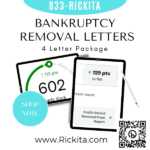Comparing Debt Management Plans and Chapter 13 Bankruptcy | Credit 101 Ep. 150
When dealing with significant debt, you might consider various strategies to regain control of your finances. Two common options are Debt Management Plans (DMPs) and Chapter 13 Bankruptcy. Understanding the differences between these approaches can help you make an informed decision based on your financial situation.
Debt Management Plans (DMPs)
What is a Debt Management Plan?
A Debt Management Plan (DMP) is a structured repayment plan designed to help individuals manage and pay off their unsecured debts over time. Typically set up through a credit counseling agency, a DMP consolidates your monthly payments into one single payment, which the agency distributes to your creditors.
Key Features of DMPs:
- Eligibility: DMPs are generally available for unsecured debts such as credit cards, medical bills, and personal loans.
- Repayment Period: Typically 3 to 5 years, with a fixed monthly payment that the credit counseling agency distributes to creditors.
- Interest Rates: Credit counseling agencies often negotiate lower interest rates with creditors.
- Fees: There may be setup and monthly fees charged by the credit counseling agency.
- Credit Impact: Enrollment in a DMP can initially affect your credit score, but it can improve as you make regular payments and reduce your debt.
- Creditor Participation: Not all creditors may agree to participate in a DMP or offer the same level of concessions.
Benefits of a DMP:
- Lower interest rates and reduced or waived fees.
- Simplified payments through a single monthly payment.
- Creditors typically stop collection calls once enrolled.
Drawbacks of a DMP:
- Impact on your credit score.
- Fees charged by the credit counseling agency.
- Limited to unsecured debts.
- Requires a long-term commitment of 3 to 5 years.
Chapter 13 Bankruptcy
What is Chapter 13 Bankruptcy?
Chapter 13 Bankruptcy, often referred to as a wage earner’s plan, allows individuals with a regular income to develop a plan to repay all or part of their debts over a specified period, usually 3 to 5 years. This type of bankruptcy is filed through the federal court system and involves a legal process to reorganize and repay debts.
Key Features of Chapter 13 Bankruptcy:
- Eligibility: Available to individuals with a regular income who have unsecured and secured debts within certain limits.
- Repayment Period: Typically 3 to 5 years, during which you make monthly payments to a court-appointed trustee.
- Interest Rates: Creditors are generally paid according to the terms set forth in the bankruptcy plan.
- Fees: Court filing fees and attorney fees apply.
- Credit Impact: Filing for Chapter 13 Bankruptcy will significantly impact your credit score and remain on your credit report for 7 years.
- Debt Discharge: Some debts may be partially discharged, while others, such as certain taxes and child support, are not eligible for discharge.
Benefits of Chapter 13 Bankruptcy:
- Allows you to keep assets such as your home and car, which might otherwise be at risk.
- Provides protection from collection actions and foreclosure.
- Can help you catch up on past-due mortgage payments or other secured debts.
Drawbacks of Chapter 13 Bankruptcy:
- Significant impact on your credit score.
- Requires a court-approved repayment plan and compliance with the plan’s terms.
- Fees for legal representation and court costs.
- Not all debts are dischargeable.
Comparing DMPs and Chapter 13 Bankruptcy
1. Eligibility and Types of Debt:
- DMPs: Suitable for unsecured debts (e.g., credit cards, medical bills).
- Chapter 13: Handles both secured and unsecured debts; allows you to repay arrears on secured debts.
2. Repayment Structure:
- DMPs: Single monthly payment to the credit counseling agency.
- Chapter 13: Monthly payments made to a bankruptcy trustee, who distributes payments to creditors.
3. Impact on Credit:
- DMPs: Temporary impact; can improve with regular payments.
- Chapter 13: Significant impact; remains on credit report for 7 years.
4. Fees:
- DMPs: Possible setup and monthly fees from the credit counseling agency.
- Chapter 13: Court filing fees and attorney fees.
5. Asset Protection:
- DMPs: No protection for assets; must continue to make payments on all debts.
- Chapter 13: Can protect assets such as your home and car from foreclosure or repossession.
6. Duration:
- DMPs: Typically 3 to 5 years.
- Chapter 13: Typically 3 to 5 years.
Conclusion
Both Debt Management Plans and Chapter 13 Bankruptcy offer ways to manage and resolve debt, but they cater to different financial situations and have distinct implications. DMPs are generally a good option for individuals with manageable unsecured debt who want to avoid bankruptcy, while Chapter 13 Bankruptcy is more suitable for those with significant debt, including secured debts, who need court protection and a structured repayment plan.
Carefully consider your financial situation, consult with a financial advisor or bankruptcy attorney, and choose the option that aligns best with your needs and long-term goals.
















